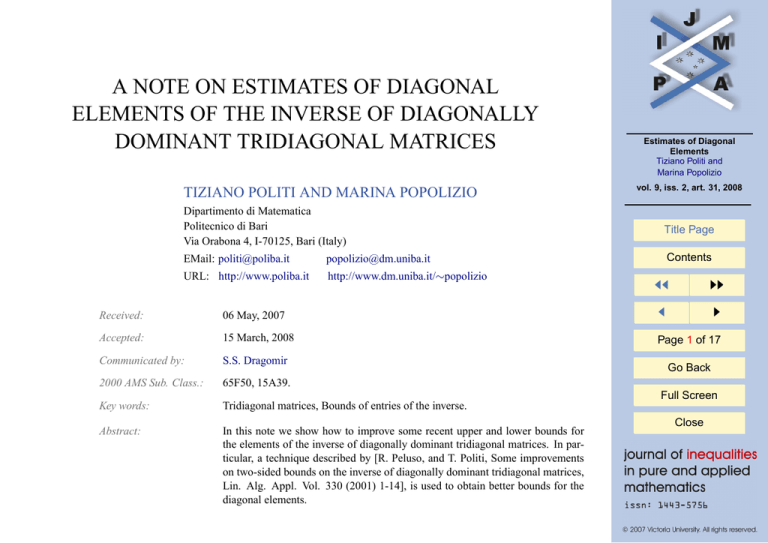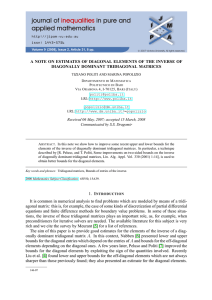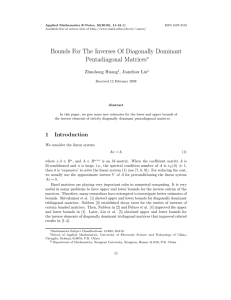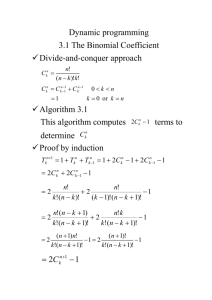A NOTE ON ESTIMATES OF DIAGONAL DOMINANT TRIDIAGONAL MATRICES JJ
advertisement

A NOTE ON ESTIMATES OF DIAGONAL
ELEMENTS OF THE INVERSE OF DIAGONALLY
DOMINANT TRIDIAGONAL MATRICES
TIZIANO POLITI AND MARINA POPOLIZIO
Estimates of Diagonal
Elements
Tiziano Politi and
Marina Popolizio
vol. 9, iss. 2, art. 31, 2008
Dipartimento di Matematica
Politecnico di Bari
Via Orabona 4, I-70125, Bari (Italy)
Title Page
EMail: politi@poliba.it
popolizio@dm.uniba.it
Contents
URL: http://www.poliba.it
http://www.dm.uniba.it/∼popolizio
JJ
II
I
Received:
06 May, 2007
J
Accepted:
15 March, 2008
Page 1 of 17
Communicated by:
S.S. Dragomir
2000 AMS Sub. Class.:
65F50, 15A39.
Key words:
Tridiagonal matrices, Bounds of entries of the inverse.
Abstract:
In this note we show how to improve some recent upper and lower bounds for
the elements of the inverse of diagonally dominant tridiagonal matrices. In particular, a technique described by [R. Peluso, and T. Politi, Some improvements
on two-sided bounds on the inverse of diagonally dominant tridiagonal matrices,
Lin. Alg. Appl. Vol. 330 (2001) 1-14], is used to obtain better bounds for the
diagonal elements.
Go Back
Full Screen
Close
Contents
1
Introduction
3
2
Some Known Results
2.1 Special cases . . . . . . . . . . . . . . . . . . . . . . . . . . . . .
5
8
3
Lower and Upper Bounds for the Diagonal Elements
10
4
Numerical Examples
14
Estimates of Diagonal
Elements
Tiziano Politi and
Marina Popolizio
vol. 9, iss. 2, art. 31, 2008
Title Page
Contents
JJ
II
J
I
Page 2 of 17
Go Back
Full Screen
Close
1.
Introduction
It is common in numerical analysis to find problems which are modeled by means
of a tridiagonal matrix: this is, for example, the case of some kinds of discretization
of partial differential equations and finite difference methods for boundary value
problems. In some of these situations, the inverse of these tridiagonal matrices plays
an important role, as, for example, when preconditioners for iterative solvers are
needed. The available literature for this subject is very rich and we cite the survey
by Meurant [5] for a list of references.
The aim of this paper is to provide good estimates for the elements of the inverse
of a diagonally dominant tridiagonal matrix A. In this context, Nabben [6] presented
lower and upper bounds for the diagonal entries which depend on the entries of A
and bounds for the off-diagonal elements depending on the diagonal ones. A few
years later, Peluso and Politi [7] improved the bounds for the diagonal elements by
exploiting the sign of the quantities involved. Recently Liu et al. [4] found lower
and upper bounds for the off-diagonal elements which are not always sharper than
those previously found; they also presented an estimate for the diagonal elements.
In this paper we propose improved bounds for the diagonal elements of the inverse; several numerical examples are also presented to confirm the good performance of the estimates. An application to preconditioning is also shown.
Let us introduce some notations; consider the following real tridiagonal matrix of
order n, with n ≥ 3,
a1 b 1
c 1 a2 b 2
..
..
..
A=
.
.
.
cn−2 an−1 bn−1
cn−1 an
Estimates of Diagonal
Elements
Tiziano Politi and
Marina Popolizio
vol. 9, iss. 2, art. 31, 2008
Title Page
Contents
JJ
II
J
I
Page 3 of 17
Go Back
Full Screen
Close
with ai 6= 0, for i = 1, . . . , n; assume that A is row diagonally dominant, i.e.
|ai | ≥ |bi | + |ci−1 |,
i = 1, . . . , n,
c0 = bn = 0.
It is natural to suppose that ci , bi 6= 0, for i = 1, . . . , n−1, as if one of these elements
is 0 the problem can be reduced to smaller subproblems, see e.g. [1].
Let C = A−1 = {ci,j } be the inverse of A.
In the following we will use some relations derived from the identity AC = I;
indeed, for the diagonal elements of C it results that
(1.1)
cj−1 cj−1,j + aj cj,j + bj cj+1,j = 1,
j = 2, . . . , n − 1
Estimates of Diagonal
Elements
Tiziano Politi and
Marina Popolizio
vol. 9, iss. 2, art. 31, 2008
while for j ≥ 3 and i = 1, . . . , j the j-th equation of the system AC = I reads
Title Page
(1.2)
ci,j
ai−1 ci−1,j + ci−2 ci−2,j
=−
.
bi−1
If bi < 0, ci < 0 and ai > 0, and a1 > −b1 or an > −cn−1 , then A is an M -matrix.
In this case ci,j > 0, ∀i, j.
The paper is organized as follows: in Section 2 we recall a collection of known
results, while in Section 3 we exploit some results described in Section 2 to improve the bounds for diagonal entries, and in Section 4 some numerical examples
are shown.
Contents
JJ
II
J
I
Page 4 of 17
Go Back
Full Screen
Close
2.
Some Known Results
The technique common to [6], [7] and [4] is bounding |ci,j |, i 6= j, as a function of
diagonal elements |cj,j | and providing suitable bounds for these.
For a review of the most recent resulting bounds presented in [4], we define the
quantities
i|
i|
ξi = |ai |−|α|bi−1
;
mi = |ai |+|α|bi−1
;
||ci−1 |
||ci−1 |
λi =
where
αi =
|ci−1 |
;
|ai |−|βi+1 ||bi |
ni
bi
,
pi
=
|ci−1 |
,
|ai |+|βi−1 ||bi |
Estimates of Diagonal
Elements
Tiziano Politi and
Marina Popolizio
vol. 9, iss. 2, art. 31, 2008
i = 1, . . . , n − 1
Title Page
pi
= ai − αi−1 ci−1 ,
βi =
qi = βi+1 bi , i = 1, . . . , n
ci−1
,
ai −qi
i = n, . . . , 2,
provided that α0 = βn+1 = 0.
Using these quantities the following bounds were derived in [4].
Theorem 2.1 ([4]). If |ai |−|βi+1 ||bi | > 0 for i = 2, . . . , n, and |ai |−|αi−1 ||ci−1 | > 0
for i = 1, . . . , n − 1, then the following bounds hold for the elements of C:
Contents
JJ
II
J
I
Page 5 of 17
Go Back
Full Screen
(2.1)
(2.2)
ni |ci−1,j | ≤ |ci,j | ≤ λi |ci−1,j |,
mi |ci+1,j | ≤ |ci,j | ≤ ξi |ci+1,j |,
i = j + 1, . . . , n, j = 1, . . . , n − 1,
i = 1, . . . , j − 1, j = 2, . . . , n,
Close
|cj,j |
(2.3)
i
Y
nk ≤ |ci,j | ≤ |cj,j |
k=j+1
|cj,j |
(2.4)
j−1
Y
i
Y
λk ,
for i > j,
k=j+1
mk ≤ |ci,j | ≤ |cj,j |
k=i
j−1
Y
ξk ,
for i < j,
Estimates of Diagonal
Elements
Tiziano Politi and
k=i
Marina Popolizio
while for the diagonal entries
(2.5)
1
|aj | + ξj−1 |cj−1 | + λj+1 |bj |
≤ |cj,j | ≤
1
|aj | − ξj−1 |cj−1 | − λj+1 |bj |
vol. 9, iss. 2, art. 31, 2008
.
Title Page
Remark 1. The hypotheses of Theorem 2.1 hold when A is a strictly diagonally
dominant or an irreducibly diagonally dominant matrix [4].
We recall the results presented in [7], for which we need the following definitions:
|bi |
τi =
|ai | − |ci−1 |
ωi =
|bi |
δi =
|ai | + |ci−1 |
i = 1, . . . , n − 1,
|ci−1 |
|ci−1 |
γi =
i = 2, . . . , n,
|ai | − |bi |
|ai | + |bi |
if aj−1 aj bj−1 cj−1 < 0;
τj−1
sj =
−δ
if aj−1 aj bj−1 cj−1 > 0,
j−1
if aj+1 aj bj cj < 0;
ωj+1
tj =
−γ
if aj+1 aj bj cj > 0,
j+1
Contents
JJ
II
J
I
Page 6 of 17
Go Back
Full Screen
Close
−τj−1
if aj−1 aj bj−1 cj−1 > 0;
δ
j−1
−ωj+1
gj =
γ
j+1
if aj−1 aj bj−1 cj−1 < 0,
fj =
if aj+1 aj bj cj > 0;
if aj+1 aj bj cj < 0.
Theorem 2.2 ([7]). Let A be a nonsingular tridiagonal matrix. If A is row diagonally dominant, then the following bounds hold for the elements of C:
(2.6)
|cj,j |
i
Y
δk ≤ |ci,j | ≤ |cj,j |
k=j+1
(2.7)
|cj,j |
j−1
Y
i
Y
γk ≤ |ci,j | ≤ |cj,j |
k=i
τk ,
for i > j;
Title Page
Contents
ωk ,
for i < j,
k=i
while for the diagonal entries
(2.8)
1
|aj | + sj |cj−1 | + tj |bj |
Marina Popolizio
vol. 9, iss. 2, art. 31, 2008
k=j+1
j−1
Y
Estimates of Diagonal
Elements
Tiziano Politi and
JJ
II
J
I
Page 7 of 17
≤ |cj,j | ≤
1
|aj | + fj |cj−1 | + gj |bj |
.
Go Back
Full Screen
Remark 2. There are few remarks for both the theorems recalled above, which have
not been stressed so far.
From both theorems it is clear that for the off-diagonal elements we have |ci,j | ≤
|ci−1,j |, since all the coefficients involved are less than 1; this leads to the well known
result about the decreasing pattern of the elements of the inverse of a banded matrix,
see e.g. [3].
Close
From the lower bounds for the diagonal entries it is clear that ci,i ≥ a1i,i , which
was a lower bound presented by Meurant [5] in the special case of diagonally dominant M -matrices, and so the estimates in (2.8) are more accurate than those in [5],
although they are more costly to evaluate.
Remark 3. For i < j, the following inequalities hold (see [4]):
mk ≥ δk ,
ξk ≤ τk ,
(2.9)
k = i, . . . , j − 1;
k = i, . . . , j − 1,
Estimates of Diagonal
Elements
Tiziano Politi and
Marina Popolizio
and, for i > j:
vol. 9, iss. 2, art. 31, 2008
nk ≥ γk ,
λk ≤ ωk ,
(2.10)
k = j + 1, . . . , i;
k = j + 1, . . . , i,
hence the bounds for the extradiagonal elements reported in Theorem 2.1 improve
those given in 2.2.
2.1.
Special cases
In the extensive survey about the inverse of tridiagonal matrices [5], Meurant considered also the special case in which one is interested in the inverse C of a Toeplitz
matrix Ta , having a on the main diagonal and −1 on the other two diagonals. The
provided upper bounds share the common idea of [4] and [7], that is |ci,j |, i 6= j,
is bounded as a function of |cj,j | and suitable bounds are presented for the diagonal
entries.
We now recall that result:
Theorem 2.3. [5] If a > 2 then
(2.11)
j−i
(Ta−1 )i,j < r−
(Ta−1 )i,i ,
∀i, ∀j ≥ i
Title Page
Contents
JJ
II
J
I
Page 8 of 17
Go Back
Full Screen
Close
(Ta−1 )i,j <
(2.12)
√
for r± =
a±
(a2 −4))
;r
2
=
j−i+1
r−
,
1−r
∀i, ∀j ≥ i + 1
r−
.
r+
Estimates of Diagonal
Elements
Tiziano Politi and
Marina Popolizio
vol. 9, iss. 2, art. 31, 2008
Title Page
Contents
JJ
II
J
I
Page 9 of 17
Go Back
Full Screen
Close
3.
Lower and Upper Bounds for the Diagonal Elements
The following example motivated our investigation. We consider the tridiagonal
matrix
4 2
−2 4 2
2
4
2
A=
−2 −4 −2
−2 4
for which the hypotheses of Theorem 2.1 are true, and compare the bounds given
by [7] and by [4]: to consider the bounds of [4], we construct the matrices U and
L whose (i, j) entry represents the upper, respectively the lower, bound in (2.3) and
in (2.4), whereas the (j, j) entry is the upper, respectively the lower, bound in (2.5).
We use the same notation for representing the bounds given in [7].
In Table 1 the maximum errors on the upper and lower bounds are represented.
From Table 1 we observe that the bounds by Liu et al. have a maximum error greater
(2.6),(2.7),(2.8)
(2.3),(2.4),(2.5)
(2.8)
(2.5)
maxi,j {Ui,j − |ci,j |}
0.4706
0.6366
maxj {Uj,j − |cj,j |}
0.1912
0.6366
maxi,j {|ci,j | − Li,j }
0.0846
0.1213
maxj {|cj,j | − Lj,j }
0.0353
0.1213
Estimates of Diagonal
Elements
Tiziano Politi and
Marina Popolizio
vol. 9, iss. 2, art. 31, 2008
Title Page
Contents
JJ
II
J
I
Page 10 of 17
Go Back
Full Screen
Close
Table 1:
than that by Peluso et al.; the reason is that the bounds derived in [4] do not improve
those on the diagonal elements hence the global bounds are not better for all the
elements of the matrix. Looking inside the bound matrices we observe that the
bounds improve for 40% of the entries and for 20% of diagonal elements when
using (2.3), (2.4) and (2.5) in place of (2.3), (2.4), (3.1).
Our aim is to obtain sharper two-sided bounds for the diagonal elements of C,
exploiting the signs of its entries, using exactly the same technique as in [7]. We
now give the main result of the present paper.
Theorem 3.1. Let A be a nonsingular tridiagonal matrix and C = A−1 . If A is row
diagonally dominant then
(3.1)
1
|aj | + sj |cj−1 | + tj |bj |
where
≤ |cj,j | ≤
1
|aj | + fj |cj−1 | + gj |bj |
ξj−1
if aj−1 aj bj−1 cj−1 < 0;
−m
j−1
λj+1
tj =
−nj+1
−ξj−1
fj =
mj−1
−λj+1
gj =
nj+1
if aj−1 aj bj−1 cj−1 > 0,
sj =
if aj+1 aj bj cj < 0;
Estimates of Diagonal
Elements
Tiziano Politi and
Marina Popolizio
,
j = 1, . . . , n,
vol. 9, iss. 2, art. 31, 2008
Title Page
Contents
JJ
II
J
I
if aj+1 aj bj cj > 0,
Page 11 of 17
if aj−1 aj bj−1 cj−1 > 0;
Go Back
if aj−1 aj bj−1 cj−1 < 0,
Full Screen
if aj+1 aj bj cj > 0;
Close
if aj+1 aj bj cj < 0,
Proof. We fix j and define µj = cj−1,j /cj,j and ρj = cj+1,j /cj,j ; if we use these
definitions in (1.1) we get
cj,j =
1
aj + µj cj−1 + ρj bj
1
=
aj 1 + µ j
cj−1
aj
b
+ ρj ajj
and
(3.2)
|cj,j | =
Estimates of Diagonal
Elements
Tiziano Politi and
1
|aj | 1 +
|c
|
ε1 |µj | |aj−1
j|
|b |
+ ε2 |ρj | |ajj |
with ε1 = sign(µj cj−1 aj ) and ε2 = sign(ρj bj aj ).
For i = j − 1, (2.2) gives
Marina Popolizio
vol. 9, iss. 2, art. 31, 2008
Title Page
mj−1 |cj,j | ≤ |cj−1,j | ≤ ξj−1 |cj,j |,
that is
(3.3)
mj−1 ≤ |µj | ≤ ξj−1 .
If ε1 > 0, then mj−1 |cj−1 | ≤ ε1 |µj ||cj−1 | ≤ ξj−1 |cj−1 |, while if ε1 < 0, then
−ξj−1 |cj−1 | ≤ ε1 |µj ||cj−1 | ≤ −mj−1 |cj−1 | and from these relations we get the
expression for sj .
It remains to show that ε1 = sign(aj aj−1 bj−1 cj−1 ).
The equation (1.2) for i = j gives
cj,j
aj−1 cj−2 cj−2,j
=−
−
.
cj−1,j
bj−1
bj−1 cj−1,j
Since |cj−2,j | ≤ |cj−1,j | and |aj−1 | > |cj−2 |, then
− sign(aj−1 bj−1 ) = sign(cj,j cj−1,j ) = sign(µj )
Contents
JJ
II
J
I
Page 12 of 17
Go Back
Full Screen
Close
from which we have the expression for ε1 .
Using exactly the same technique, we may work on the upper bounds and discuss
the influence of ε2 , as in [7].
Again, as in [7], we can write explicit bounds when A is an M -matrix.
Remark 4. If A is an M -matrix, then the bounds proved in Theorem 3.1 become
1
aj − mj−1 |cj−1 | − nj+1 |bj |
≤ cj,j ≤
1
aj − ξj−1 |cj−1 | − λj+1 |bj |
,
j = 1, . . . , n.
We note that the upper bound is the same as that in [4] but the lower bound is sharper.
Remark 5. As a consequence of (2.9) and (2.10), the bounds proved in Theorem 3.1
are sharper (or not worse) than those shown in [4].
Estimates of Diagonal
Elements
Tiziano Politi and
Marina Popolizio
vol. 9, iss. 2, art. 31, 2008
Title Page
Contents
JJ
II
J
I
Page 13 of 17
Go Back
Full Screen
Close
4.
Numerical Examples
As one may expect, all the lower and upper bounds presented above do not depend
on the dimension of the matrices involved. All the numerical experiments we did
showed in fact that varying the dimension of the matrix does not influence the accuracy of the estimates. For this reason, in this section we consider problems of small
size, but we stress that our results work well also for much larger problems.
Example 4.1. Let
Estimates of Diagonal
Elements
Tiziano Politi and
Marina Popolizio
−34 −13.4
3
0.5
−2.2
3.3
45 −2.3
A=
2.1 −22 0.6
3
15 0.22
1.3 42
and let B be the inverse of A, computed by using the Matlab function inv. For
considering the bounds (2.3), (2.4), (2.5) of Liu et al. [4], we construct the matrices
U and L whose (i, j) entry represents the upper, respectively the lower, bound in
(2.3) and in (2.4), whereas the (j, j) entry is the upper, respectively the lower, bound
in (2.5). We use the same notation for representing the bounds obtained by using
(2.3), (2.4) with the diagonal bounds (3.1).
The entries of Table 2 show an improvement in the accuracy of the estimates of
at least two orders of magnitude.
Example 4.2. An important example of strictly diagonally dominant tridiagonal ma-
vol. 9, iss. 2, art. 31, 2008
Title Page
Contents
JJ
II
J
I
Page 14 of 17
Go Back
Full Screen
Close
maxi,j {Ui,j − |ci,j |}
2.4119e − 003
2.1600e − 001
maxj {Uj,j − |cj,j |}
1.7895e − 004
2.1600e − 001
(2.3), (2.4), (3.1)
(2.3), (2.4), (2.5)
(2.3), (2.4), (3.1)
(2.3), (2.4), (2.5)
maxi,j {|ci,j | − Li,j }
4.0993e − 004
1.0290e − 001
maxj {|cj,j | − Lj,j }
2.4253e − 005
4.9282e − 003
Table 2: Comparison with the Liu et al.’s upper bounds
Estimates of Diagonal
Elements
Tiziano Politi and
Marina Popolizio
trices is
vol. 9, iss. 2, art. 31, 2008
4 −1
−1 4 −1
−1 4 −1
T4 =
.. ..
.
.
−1 4
;
it arises when discretizing the Laplace operator on a rectangular domain with Dirichlet boundary conditions: it actually represents the structure of the diagonal blocks of
the discretization of the Laplacian obtained by applying a five-point finite difference.
In [2], Benzi and Golub used this matrix to test an approximate inverse; they
stress that an approximate inverse of T4 is needed in the initial step of an incomplete
Cholesky factorization for the two-dimensional model problem. By applying the
equations (2.3), (2.4), (3.1) we are able to obtain good bounds for the generic entry
of T4−1 . We define the matrices U and L as in the previous example and, with a very
naïve idea, we consider the matrix M := 21 (U + L) as an approximant to T4−1 ; we
use a matrix T4 of dimension 100 × 100.
As in [2], we use the condition number cond of the matrix M T4 to test the quality
Title Page
Contents
JJ
II
J
I
Page 15 of 17
Go Back
Full Screen
Close
of the approximation. We notice that cond(M T4 ) = 1.0736, from which we may
state that M would be an effective preconditioner.
As mentioned in [2], it is well known that, due to the decay of the elements of the
inverse, considering only the tridiagonal approximations provides good results. We
considered only the tridiagonal part of M , say M1 , to obtain cond(M1 T4 ) = 1.2185.
With the same matrix T4 , the upper bounds in (2.3) and (2.4) are sharp when we
use (3.1) for the diagonal entries. We in fact observed that
max{Ui,j − |ci,j |} < 10−16 ,
i,j
Estimates of Diagonal
Elements
Tiziano Politi and
Marina Popolizio
vol. 9, iss. 2, art. 31, 2008
where Uij and cij represent, respectively, the (i, j) entry of matrices U , of the upper
bounds (2.3), (2.4) and (3.1), and T4−1 .
Example 4.3. We consider the Toeplitz matrix T4 of dimension 8 × 8; we compare
the upper bounds presented in this paper with those proposed by Meurant [5].
(2.3), (2.4), (3.1)
(2.11)
(2.3), (2.4), (3.1)
(2.12)
maxi;j≥i {Ui,j − |ci,j |}
8.6736e − 019
1.2780e − 007
maxi;j≥i+1 {Ui,j − |ci,j |}
2.8709e − 017
5.7654e − 003
Title Page
Contents
JJ
II
J
I
Page 16 of 17
Go Back
Full Screen
Table 3: Comparison with the Meurant’s upper bounds
The results in Table 3 show an impressive improvement when using the bounds
(2.3), (2.4), (3.1).
Close
References
[1] W.W. BARRETT, A theorem on inverses of tridiagonal matrices, Lin. Alg. Appl.,
27 (1979), 211–217.
[2] M. BENZI AND G.H. GOLUB. Bounds for the entries of matrix functions with
applications to preconditioning, BIT, 39(3) (1999), 417–438.
[3] P. CONCUS, G.H. GOLUB AND G. MEURANT, Block preconditioning for the
conjugate gradient methods, SIAM J. Sci. Stat. Comput., 6 (1985), 220–252.
[4] X.Q. LIU, T.Z. HUANG AND Y.D. FU, Estimates for the inverse elements of
tridiagonal matrices, Appl. Math. Lett., 19 (2006), 590–598.
[5] G. MEURANT, A review on the inverse of symmetric tridiagonal and block
tridiagonal matrices, SIAM J. Matrix Anal. Appl., 13(3) (1992), 707–728.
[6] R. NABBEN, Two-sided bounds on the inverse of diagonally dominant tridiagonal matrices, Lin. Alg. Appl., 287 (1999), 289–305.
[7] R. PELUSO AND T. POLITI, Some improvements on two-sided bounds on the
inverse of diagonally dominant tridiagonal matrices, Lin. Alg. Appl., 330 (2001),
1–14.
[8] P.N. SHIVAKUMAR AND CHUANXIANG JI, Upper and lower bounds for inverse elements of finite and infinite tridiagonal matrices, Lin. Alg. Appl., 247
(1996), 297–316.
Estimates of Diagonal
Elements
Tiziano Politi and
Marina Popolizio
vol. 9, iss. 2, art. 31, 2008
Title Page
Contents
JJ
II
J
I
Page 17 of 17
Go Back
Full Screen
Close





